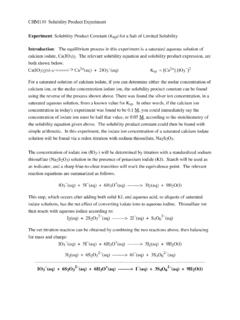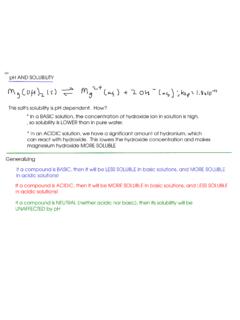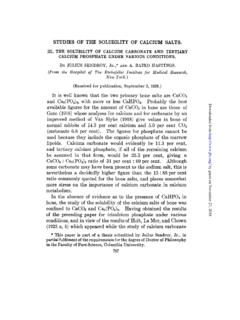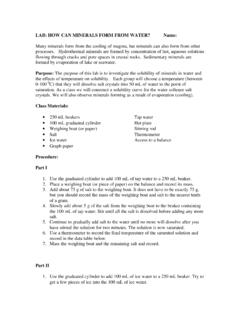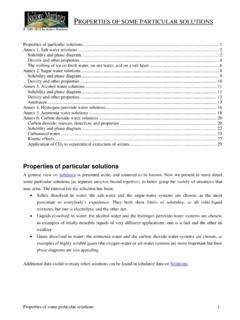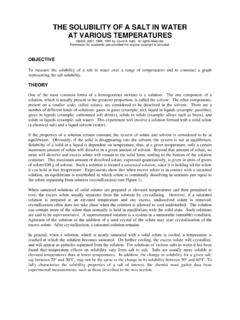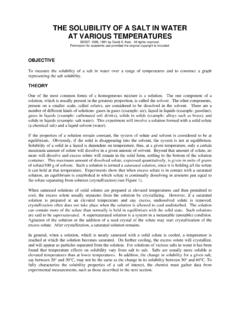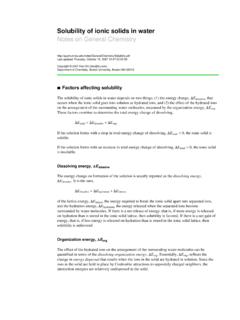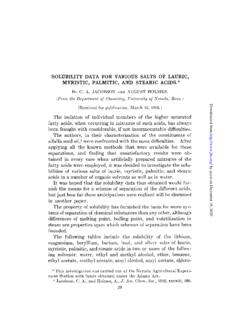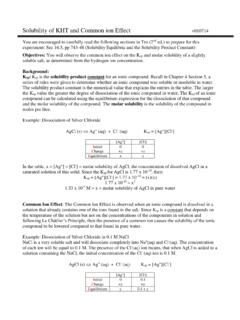Transcription of Determining Solubility of an Unknown Salt at Various ...
1 COPYRIGHT FOUNTAINHEAD PRESS Determining Solubility of an Unknown salt at Various Temperatures Objectives: To determine Solubility of an Unknown inorganic salt in water as a function of temperature; to construct a Solubility -temperature curve; and identify the Unknown salt by comparing experimental curve with reference curves Materials: Unknown inorganic salts; distilled water Equipment: 25 x 250-mm test tube with 2-hole rubber stopper; thermometer; glass or wire stirring rod; iron rings and ring stand assembly (see Figure 2); ceramic-centered gauze heating pad; 400-mL beaker; Bunsen burner Safety: Some inorganic salts/so lut ions are irritants. All samples and solutions should be handled carefully. Hot glassware should be handled with care. Eye goggles should be worn at all times in the lab.
2 Waste Disposal: salt solutions should be placed in the inorganic waste container provided in the fume hood. INTRODUCTION What do iced tea, soda pop, and salt water have in common? These and many other substances you use every day are mixtures that chemists call solutions. A solution is defined as a homogenous mixture in which one or more substances dissolve completely in another substance. The substances that dissolve are called solutes, while the substance in which they dissolve is called the solvent. Take, for example, a cup of hot tea; the Various compounds in the tea leaves that dissolve in the hot water are solutes, as is the sugar that is added to sweeten the tea. The hot water is the solvent. The Solubility of a given solute is defined as the amount of solute that will dissolve in solution at a given temperature.
3 For aqueous solutions, solubilities are typically reported in units of grams of salt per 100 mL of water (g salt /100 mL H2O). The amount of solute that will dissolve in water depends on many factors, including temperature and the nature of the solute and solvent ( , molecular vs ionic, polar vs non- polar). Salts, such as table salt (sodium chloride), are io nic co mpounds consisting of cations and anions; ionic compounds are usually soluble in water, but the extent of Solubility will vary from one salt to another. COPYRIGHT FOUNTAINHEAD PRESS Generic terms, such as concentrated or dilute, can be used to describe how much so lute is disso lved in so lution. Chemists use the term saturated to describe a solution that contains the maximum mass of dissolved solute at a given temperature.
4 Solutions that contain less than this maximum amount are called unsaturated, while those that contain more are called supersaturated. Supersaturated solutions are typically achieved by preparing a saturated solution at a high temperature, and then cooling the solution. In this exercise you will examine the effect of temperature on the Solubility of an Unknown inorganic salt . You will observe how Solubility changes with temperature and use this information to construct a solubilit y-temperature curve. By comparing your experimental curve with examples of known salts you will identify your Unknown salt sample. Solutions Anyone who has made iced tea knows that the amount of sugar that dissolves in the tea changes with temperature. At high temperatures the sugar dissolves easily.
5 As the tea cools, however, some of the dissolved sugar may recrystallize, or come out of solution. At this point, we know that the solution is saturated with respect to the solute (sugar) the solution contains as much dissolved sugar as it can hold at that temperature, and the excess has precipitated from solution and remains undissolved. We can prepare a saturated salt solution by mixing a measured volume of water with a greater mass of salt than can dissolve at a given temperature; excess salt remains undissolved. The system is dynamic; some salt particles may recrystallize as dissolved ions recombine to form solid, while some solid particles dissolve into solution. The total mass of dissolved salt and the overall so lution co mposit ion remain constant as long as the temperature does not change.
6 Alternatively, we could add an excess of salt to a measured volume of water and heat the water until all the salt dissolved. At this point we have an unsaturated solution; the amount of salt dissolved in solution is less than the maximum that the water can hold at that temperature. As the water cools, the Solubility of the salt decreases until the mass of salt in solution exceeds the solubilit y. The temperature at which salt starts to recrystallize is called the saturation temperature. Effect of Temperature on Solubility Many factors affect the Solubility of a salt in aqueous solut ion. One of the major factors is the attractive forces between the ions in the solid salt compared to the attractive forces between the io ns and the polar solvent, water. If the attractive forces between the ionic particles and the solvent are greater than the attractive forces between the cations and anions in the solid crystal lattice, then the salt will dissolve readily and heat energy will be released ( , the solution feels warm).
7 Conversely, if the attractive forces between the ions is greater than the interactions between solvent and ions, then heat energy is absorbed by the solution ( , the solution cools down). For most salts heat is absorbed when they dissolve in water; their Solubility increases as the temperature of the solution increases. COPYRIGHT FOUNTAINHEAD PRESS Figure 1. Solubility -temperature curves for Various inorganic salts in water. We can most easily visualize the effect of temperature on the Solubility of a salt by plotting the solubilit y o f a salt vs. saturation temperature. A Solubility -temperature curve consists of the experimentally determined saturation temperatures on the abscissa (x-axis) and the concentration of salt in the saturated solution on the ordinate (y-axis). Solubilit y-temperature curves can be used to estimate the salt concentration of saturated solutions at temperatures other than those determined experimentally.
8 In addition, Unknown salts may be identified by comparing the experimental so lubilit y-temperature curves with curves of known salts. So lubilit y-temperature curves of several inorganic salts are presented in Figure 1. In this experiment you will create a Solubility -temperature curve for an Unknown salt by dissolving a known mass of salt in Various measured volumes of water. These solutions will be heated to ensure complete dissolution of the salt . As the solution cools, you will observe the saturation temperature of each solution. The concentration of each solution can be calculated using Equation 1. experimental mass of salt (g)concentration of salt solution =100total volume of water (mL) Using your calculated solution concentrations and experimentally determined saturation temperatures, you will construct a Solubility -temperature curve for your Unknown salt and identify your Unknown salt .
9 COPYRIGHT FOUNTAINHEAD PRESS Pre-Lab Questions 1. What is the difference between a saturated solution and an unsaturated solution? 2. Briefly explain how the Solubility of most salts is related to temperature. What general trend is observed, and why? 3. What factors determine the Solubility of a salt in water? Explain. 4. A student is evaluating the Solubility potassium chlorate (KClO3) at Various temperatures. She dissolves g of KClO3 in a total volume of mL of water. a. Calculate the concentration of KClO3 in this solution. b. The student heats the solution up to 80 C, and then removes the test tube containing the salt solution from the hot water bath. At what temperature would you expect to see the formation of salt crystals in the so lut ion? (Refer to Figure 1 in the Introduction.) c. If the solution is allowed to cool to 30 C, what percentage of the salt remains disso lved in so lut ion?
10 COPYRIGHT FOUNTAINHEAD PRESS PROCEDURE 1. Obtain a test tube and stopper, and assemble the apparatus illustrated in Figure 2. NOTE: If the thermometer and stirring rod are not already inserted in the rubber stopper, insert them carefully. Apply a small amount of glycerine or other lubricant to the stopper holes. Grasp the thermometer or glass rod with a cloth or paper towel, and carefully insert into the stopper hole using a twisting motion while applying gentle pressure. Excessive force may result in breakage and possible injury. Fill the 400-mL beaker with approximately 300 mL of water, and place on the wire gauze pad as illustrated in Figure 2. 2. Place the clamp assembly holding the test tube and stopper on the ring stand, but do not lower it into the beaker at this time.





